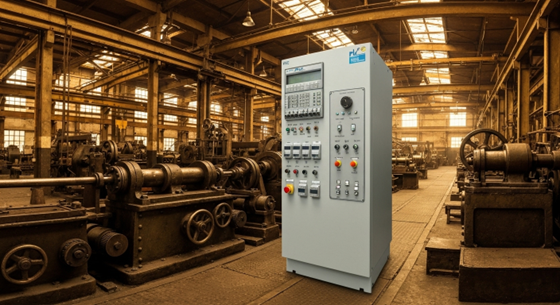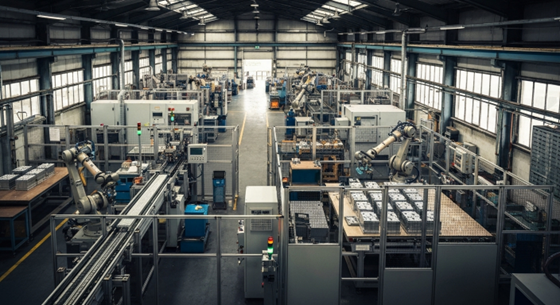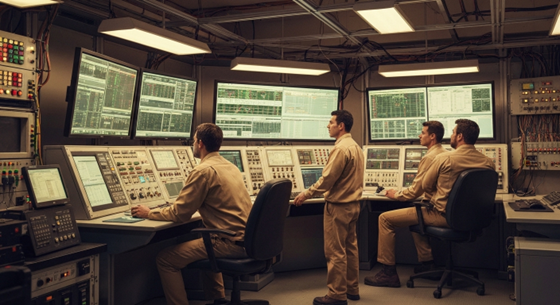Key Benefits of Implementing Automation PLC Solutions
Key Highlights
- A programmable logic controller (PLC) is a rugged industrial computer that forms the core of modern industrial automation.
- The main functions of a PLC involve monitoring input devices, executing programmed logic, and controlling output devices to automate processes.
- PLCs execute a continuous scan cycle to enable real-time process control in demanding industrial settings.
- These control systems offer superior flexibility, reliability, and scalability compared to older hard-wired relay logic.
- Implementing PLC solutions boosts productivity, enhances efficiency, and provides significant cost savings across various industries.
- They are essential for applications ranging from manufacturing and automotive assembly to energy management and food processing.
Introduction
In the competitive landscape of modern industry, efficiency and reliability are paramount. Industrial automation has become the key to unlocking new levels of productivity, and at the heart of these advanced automation systems are programmable logic controllers (PLCs). These powerful devices act as the brains behind the brawn, orchestrating complex machinery and processes with precision and consistency. If you've ever wondered how large-scale manufacturing and industrial tasks are managed so seamlessly, the answer often lies in the strategic implementation of PLC technology.
Understanding PLCs in Automation

A programmable logic controller is essentially a specialized industrial computer built to withstand the harsh conditions of a factory floor. Unlike a standard PC, a PLC is designed for the specific task of controlling automated processes in real time.
The main difference lies in its robust construction and dedicated functionality. It forms the backbone of an automated system by taking in information, processing it, and executing commands to manage machinery. Let's explore what a PLC is in more detail and look at the components that make it work.
What Is a Programmable Logic Controller (PLC)?
At its core, a programmable logic controller is an industrial digital computer designed for the control of machinery and industrial processes. It was originally developed in the late 1960s to replace hard-wired relay logic systems, offering a more flexible and reliable alternative for automation systems. Think of it as a highly durable and specialized computer that can survive in environments with extreme temperatures, vibrations, and electrical noise.
How is it used in automation? A PLC continuously monitors the state of input devices—like sensors, buttons, and switches—and makes decisions based on a custom program. Based on this logic, it controls output devices such as motors, valves, lights, and solenoids.
This capability allows PLCs to automate a single machine or an entire production line. From simple on-off control to complex sequencing, a PLC provides the intelligence needed to execute tasks repeatably and accurately, making it a cornerstone of modern manufacturing and industrial control.
Core Components of a PLC System
A PLC system is composed of several key components working together to provide reliable control. Understanding these parts helps clarify how the entire system functions to automate industrial tasks. Each component has a specific role, from processing logic to interacting with the physical world.
The modular design of many PLCs allows you to customize a system to fit the precise needs of your application. The primary elements are housed together in a rack or compact unit, forming a complete control solution.
The core components typically include:
- Central Processing Unit (CPU): This is the brain of the PLC. The processing unit executes the user-created program, processes input data, and determines the appropriate output actions.
- Input/Output (I/O) Modules: These modules form the physical connection between the PLC and the machinery it controls. Input devices (sensors) connect to input modules, while output devices (motors) connect to output modules.
- Programmable Memory: This consists of RAM and ROM to store the operating system, device drivers, and the user's application program.
- Power Supply: This component converts incoming AC power to the DC power required by the CPU and other internal components.
- Communication Protocols: These enable the PLC to communicate with other devices, such as other PLCs, HMIs (Human-Machine Interfaces), and SCADA systems.
How PLCs Work in Automated Environments

The operation of a programmable logic controller is defined by a simple, repetitive process known as the scan cycle. During this cycle, the PLC reads the status of all connected input devices, executes the control program you’ve written, and then updates the status of the output devices accordingly. This sequence happens in milliseconds, enabling automatic control in real time.
This cyclical operation ensures that the PLC is constantly responsive to changes in the industrial environment. Programming languages like ladder logic are used to define the rules for how input data should influence output signals. The following sections will break down these operations further.
Input and Output Operations Explained
A PLC’s ability to control processes hinges on its interaction with input and output devices. Inputs are the signals the PLC receives from the system, while outputs are the commands it sends back to control the machinery. These signals can be either digital or analog.
Input devices provide the data the PLC needs to make decisions. Digital inputs are simple on/off signals, like a switch being open or closed. Analog signals, however, provide a range of values, such as a pressure reading or a temperature measurement. Examples of input devices include sensors, pushbuttons, and switches.
Based on the logic in its program, the PLC sends signals to connected output devices to perform an action. These can include:
- Turning electric motors on or off
- Opening or closing valves
- Activating alarms or indicator lights
- Adjusting the speed of a drive
These actions allow the PLC to manage everything from a simple conveyor belt to a complex robotic arm.
Scan Cycle and Data Processing
The scan cycle is the fundamental process through which a PLC operates. This repetitive loop allows the controller to perform data acquisition and execute its programmable logic in near real time, ensuring a rapid response to changing conditions on the plant floor.
The cycle consists of four main steps. First is the input scan, where the PLC detects the status of all connected inputs. Second, the PLC executes the user program one instruction at a time, using the input data it just read to make logical decisions.
Third, the PLC updates the status of all output devices based on the program's results. Finally, it performs a housekeeping step, which includes internal diagnostics and communication tasks. This entire scan cycle repeats continuously, often thousands of times per second, enabling precise and reliable control even in environments with extreme temperatures.
Main Functions of PLCs in Industrial Automation
The main functions of a PLC extend beyond simple on-off control. These controllers are capable of handling a variety of complex tasks required in modern industrial automation. Their ability to perform these functions in real time makes them indispensable for efficient and safe operations.
Key roles include sequential control, motion control, and process control. By executing these functions, a PLC can manage everything from a simple assembly line to a sophisticated chemical manufacturing process. We will now look at how a PLC handles logic control and data monitoring.
Logic Control and Sequencing
One of the primary functions of a PLC is logic control and sequencing. This involves executing a program to control the order of operations in a machine or process. Think of an automated car wash: the PLC ensures the soap, brushes, rinse, and drying cycles happen in the correct sequence and for the right duration.
This control is achieved using programming languages that are intuitive for engineers. Ladder logic, for example, is a graphical language that resembles the electrical relay circuits it replaced. Other languages like function block diagrams (FBD) and sequential function charts (SFC) also provide clear ways to structure control logic.
These languages allow plant engineers to easily create, modify, and troubleshoot complex sequences for a vast range of industrial applications. This flexibility is a significant advantage over old, hard-wired systems, where changing a sequence required physically rewiring control panels.
Monitoring and Data Acquisition
Beyond just controlling machinery, PLCs are vital for monitoring and data acquisition. They act as the on-the-ground data collectors, gathering real-time information from sensors and equipment across the plant floor. This can include everything from production counts and cycle times to temperature and pressure readings.
This collected data is then relayed to higher-level systems for analysis and supervisory control. A PLC often serves as a crucial link to a SCADA (Supervisory Control and Data Acquisition) system or an HMI (Human-Machine Interface), which presents the information to a human operator in a user-friendly format.
This allows operators to oversee the entire process, identify potential issues before they cause downtime, and analyze complex data to optimize performance. According to Inductive Automation, "PLCs act as the physical interfaces between devices on the plant or manufacturing floor and a SCADA or HMI system." [Source: https://inductiveautomation.com/resources/article/what-is-a-plc]
Advantages Over Traditional Relay Control
Before the adoption of PLCs in the late 1960s, industrial control was managed by complex panels of hard-wired relays, timers, and counters. This approach, known as traditional relay control, was inflexible and difficult to maintain. The main difference is that a PLC replaces this physical wiring with a software program.
This shift from hardware-based relay logic to software-based programmable logic brought revolutionary advantages. PLCs offer far greater flexibility, improved reliability, and easier troubleshooting, fundamentally changing the landscape of industrial automation. Let's explore these benefits in more detail.
Flexibility and Scalability
One of the most significant advantages of PLCs is their inherent flexibility. With a traditional relay system, changing a control sequence meant physically rewiring the entire panel—a time-consuming and error-prone task. With a PLC, you can modify the same process by simply editing the software program and uploading the new logic.
This ability to reprogram makes it easy to adapt to changing production requirements or correct errors without significant downtime or cost. Furthermore, PLCs offer excellent scalability. Modern PLCs are often modular, allowing you to add more input or output modules as your system grows.
This makes for easy integration of new equipment or processes. A manufacturer might offer a whole family of controllers, like the Allen-Bradley Logix family from Rockwell Automation, allowing you to scale from small, single-machine applications to large, plant-wide systems using a common programming environment. [Source: https://www.rockwellautomation.com/en-us/products/hardware/allen-bradley/programmable-controllers.html]
Enhanced Reliability and Reduced Downtime
PLCs are designed as solid-state industrial computers with no moving parts. This is a stark contrast to mechanical relays, which can wear out and fail over time. The robust design of a PLC drastically improves the system's overall reliability, which in turn leads to reduced downtime.
These controllers are built to operate consistently in harsh industrial environments. They can withstand vibrations, high humidity, electrical noise, and extreme temperatures that would cause a standard computer to fail. This durability ensures that your production lines keep running smoothly.
When issues do arise, troubleshooting a PLC system is often much faster than diagnosing a fault in a complex web of relay wiring. Many issues can be identified through software diagnostics, allowing engineers to pinpoint and resolve problems quickly. This enhanced reliability directly translates to more uptime and greater productivity.
Key Benefits of PLC-Based Automation Solutions

Implementing a PLC-based automated system brings a host of powerful benefits that directly impact your bottom line. These solutions are designed to optimize machine performance, streamline workflows, and give you greater control over your entire operation. An automated system powered by a PLC is more than just a replacement for manual labor; it's a strategic upgrade.
By leveraging a PLC, you can achieve higher levels of efficiency, precision, and data visibility. These improvements lead to better resource optimization and a more agile manufacturing process. Let's examine how this translates into improved productivity and significant cost savings.
Improved Productivity and Efficiency
One of the most immediate benefits of PLC automation is a dramatic increase in productivity. PLCs enable machines to perform repetitive tasks faster, more consistently, and for longer periods than a human operator ever could. This higher throughput means more products can be manufactured in less time.
Efficiency also sees a major boost. Through precise process control, PLCs minimize waste of raw materials and reduce the number of rejected products caused by human error. For plant engineers, this means achieving better overall equipment effectiveness (OEE) and more predictable production schedules.
The key advantages for improving machine performance and efficiency include:
- Faster cycle times for automated tasks.
- Consistent and repeatable product quality.
- 24/7 operation capabilities with minimal supervision.
- Reduced errors and material waste.
Cost Savings and Resource Optimization
The improved efficiency from PLC automation directly translates into significant cost savings. By automating complex operations, you reduce reliance on manual labor for repetitive tasks. More importantly, resource optimization helps lower operational expenses across the board. Optimized motor control, for example, can reduce energy consumption.
Precise control over processes also minimizes raw material waste, leading to direct savings. Additionally, the high reliability of PLCs reduces maintenance costs and the financial impact of unplanned downtime compared to older systems. Over time, a PLC becomes the primary automation method that delivers a strong return on investment.
Here’s a comparison of how PLCs provide cost savings over traditional methods:
| Feature | Relay Logic Control | PLC Automation |
|---|---|---|
| Modification Cost | High; requires physical rewiring and labor. | Low; requires a simple software update. |
| Energy Consumption | Less efficient; can lead to wasted energy. | Optimized control reduces energy usage. |
| Downtime Costs | Higher; mechanical failures are common and hard to trace. | Lower; solid-state reliability and faster diagnostics. |
| Material Waste | Higher due to less precise control. | Minimal due to precise and repeatable process control. |
Industries That Benefit Most From PLC Automation
PLC automation is not limited to a single sector; its benefits extend across a wide range of industries. The adaptability of PLCs allows them to meet unique industry demands, whether in sterile food processing environments or rugged, remote locations for oil and gas extraction. Any industry that relies on electromechanical processes can gain an edge with PLC control.
From high-speed manufacturing to critical utility services, PLCs provide the required reliability and precision. Let's look at a few key sectors where these controllers have become an indispensable technology.
Manufacturing and Automotive Applications
In the manufacturing sector, PLCs are the undisputed workhorses of the factory floor. They control industrial processes ranging from simple product assembly and packaging to complex robotic welding and CNC machining. Their ability to execute tasks with high speed and precision is essential for mass production.
The automotive industry, in particular, relies heavily on PLCs for its assembly lines. These controllers orchestrate the sophisticated dance of robotic arms that weld car bodies, paint panels, and install components. The precise motion control provided by PLCs is critical for ensuring that every vehicle meets strict quality and safety standards.
By managing these complex sequences, PLCs help to maximize machine performance and throughput. Their reliability ensures that production lines can run continuously with minimal interruption, which is crucial in an industry where downtime is extremely costly.
Utilities, Energy, and Process Industries
PLCs play a critical role in the utilities and energy sectors, where reliability is a matter of public service. They are used in power plants to control generation processes and in substations to manage the distribution of electricity across the grid. These systems often operate in harsh industrial environments and must function flawlessly.
In process industries like oil and gas, chemical manufacturing, and water treatment, PLCs are essential for process control. They manage variables such as pressure, flow, and temperature to ensure both safety and efficiency. Often, they are integrated with large-scale SCADA systems for centralized monitoring and control.
Key applications in these industries include:
- Water/Wastewater: Controlling pumps, valves, and chemical dosing systems.
- Energy Management: Automating power grids and renewable energy sources.
- Food and Beverage: Managing batching, mixing, and cooking processes.
- Oil and Gas: Monitoring pipelines and controlling refinery operations.
Selecting the Right PLC for Your Automation Project
Choosing the correct PLC for your automation project is a critical decision that will impact its success, cost, and future scalability. There is no one-size-fits-all solution; the ideal choice depends on the specific requirements of your application. You'll find a wide family of controllers on the market, ranging from compact, fixed I/O units for small, standalone machines to powerful, modular systems for complex, plant-wide control. When making your selection, you need to assess factors like the number and type of I/O points required, the complexity of the control logic, and the necessary communication capabilities.
Consideration of the programming software is also essential. A platform with intuitive programming languages like ladder logic or function block diagrams can simplify development and maintenance. The physical connection options and compatibility with existing HMI or SCADA systems should also be evaluated to ensure seamless integration.
Factors to Consider When Choosing a PLC
When narrowing down your PLC options, there are several specific factors to evaluate to ensure you make the right choice. A thorough assessment of your project's needs will prevent you from overspending on an unnecessarily complex system or, conversely, choosing a controller that can't handle your application's demands.
Thinking about both current requirements and future growth is key. Scalability and easy integration with other systems can save you significant time and money down the road. According to a guide from Paessler, PLCs are specialized devices built to withstand harsh environmental conditions, a factor that should be part of your selection criteria. [Source: https://www.paessler.com/info/plc]
Here are some critical factors to consider:
- I/O Requirements: Determine the number and type of inputs and outputs needed (digital, analog, temperature, etc.).
- Environmental Conditions: Assess the operating environment. Will the PLC be exposed to extreme temperature ranges, humidity, or high levels of electrical noise?
- Processing Speed and Memory: Complex or high-speed applications require a faster processor and more memory.
- Communication Needs: Identify the necessary communication protocols (e.g., EtherNet/IP, Modbus) and if control of remote locations is needed.
- Safety Requirements: For applications where failure could cause harm, a certified safety PLC is often required.
Conclusion
In conclusion, implementing automation PLC solutions can significantly transform your operations across various industries. By enhancing productivity, ensuring reliability, and optimizing resource usage, PLCs stand out as a vital component of modern automation systems. Their flexibility and scalability allow businesses to adapt to changing demands while minimizing downtime. As you consider integrating PLC technology into your processes, it's essential to evaluate the specific needs of your application to select the right PLC system. Don't hesitate to explore how these solutions can streamline your operations and drive overall efficiency. If you're ready to take the next step, reach out for a consultation to discover the best PLC automation strategies for your business.
Frequently Asked Questions
How is PLC programming typically carried out for automation?
PLC programming is performed on a computer using dedicated programming software provided by the PLC manufacturer. Engineers write instructions using standardized programming languages, with ladder logic and function block diagrams being the most common. The completed program is then downloaded to the PLC's memory for execution.
What skills or certifications are needed to work with PLCs in the U.S.?
Plant engineers and technicians typically need a strong understanding of electrical principles, industrial computers, and PLC programming languages. While a degree in engineering is common, vendor-specific certifications from companies like Rockwell Automation or Siemens on a particular PLC system are highly valued by employers.
Are PLC solutions suitable for small and medium-sized businesses?
Yes, PLC solutions are highly suitable for SMBs. Thanks to their flexibility and scalability, there is a wide family of controllers ranging from affordable, compact units for simple industrial applications to modular systems. They offer a significant and cost-effective upgrade over traditional relay logic for any size operation.



